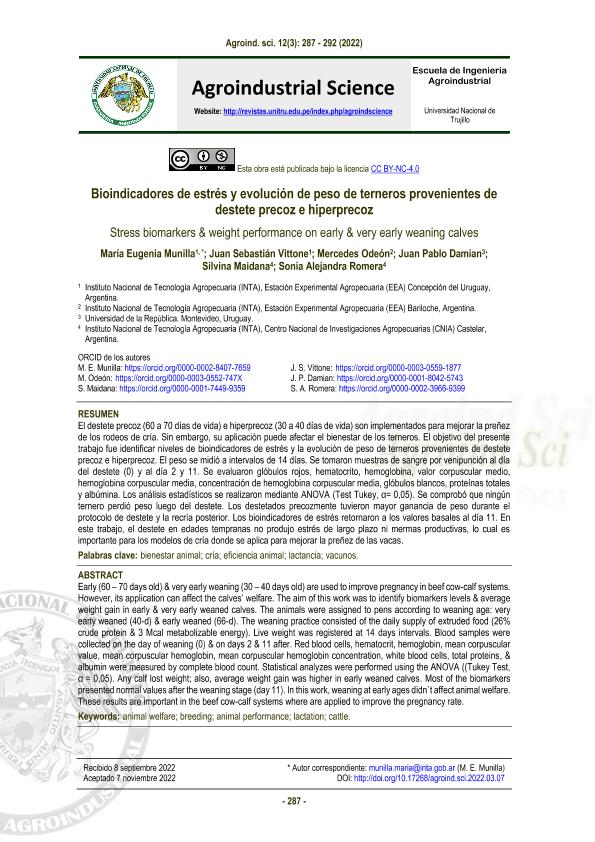Mostrar el registro sencillo del ítem
dc.contributor.author
Munilla, María Eugenia

dc.contributor.author
Vittone, Juan Sebastian

dc.contributor.author
Odeón, Mercedes
dc.contributor.author
Damian, Juan Pablo

dc.contributor.author
Maidana, Silvina Soledad

dc.contributor.author
Romera, Sonia Alejandra
dc.date.available
2023-06-21T17:21:42Z
dc.date.issued
2022-12
dc.identifier.citation
Munilla, María Eugenia; Vittone, Juan Sebastian; Odeón, Mercedes; Damian, Juan Pablo; Maidana, Silvina Soledad; et al.; Bioindicadores de estres y evolucion de peso de terneros provenientes de destete precoz e hiperprecoz; Universidad Nacional de Trujillo; Agroindustrial Science; 12; 3; 12-2022; 287-292
dc.identifier.issn
2226-2989
dc.identifier.uri
http://hdl.handle.net/11336/201028
dc.description.abstract
El destete precoz (60 a 70 días de vida) e hiperprecoz (30 a 40 días de vida) son implementados para mejorar la preñez de los rodeos de cría. Sin embargo, su aplicación puede afectar el bienestar de los terneros. El objetivo del presente trabajo fue identificar niveles de bioindicadores de estrés y la evolución de peso de terneros provenientes de destete precoz e hiperprecoz. El peso se midió a intervalos de 14 días. Se tomaron muestras de sangre por venipunción al día del destete (0) y al día 2 y 11. Se evaluaron glóbulos rojos, hematocrito, hemoglobina, valor corpuscular medio, hemoglobina corpuscular media, concentración de hemoglobina corpuscular media, glóbulos blancos, proteínas totales y albúmina. Los análisis estadísticos se realizaron mediante ANOVA (Test Tukey, α= 0,05). Se comprobó que ningún ternero perdió peso luego del destete. Los destetados precozmente tuvieron mayor ganancia de peso durante el protocolo de destete y la recría posterior. Los bioindicadores de estrés retornaron a los valores basales al día 11. En este trabajo, el destete en edades tempranas no produjo estrés de largo plazo ni mermas productivas, lo cual es importante para los modelos de cría donde se aplica para mejorar la preñez de las vacas.
dc.description.abstract
Early (60 – 70 days old) & very early weaning (30 – 40 days old) are used to improve pregnancy in beef cow-calf systems. However, its application can affect the calves’ welfare. The aim of this work was to identify biomarkers levels & average weight gain in early & very early weaned calves. The animals were assigned to pens according to weaning age: very early weaned (40-d) & early weaned (66-d). The weaning practice consisted of the daily supply of extruded food (26% crude protein & 3 Mcal metabolizable energy). Live weight was registered at 14 days intervals. Blood samples were collected on the day of weaning (0) & on days 2 & 11 after. Red blood cells, hematocrit, hemoglobin, mean corpuscular value, mean corpuscular hemoglobin, mean corpuscular hemoglobin concentration, white blood cells, total proteins, & albumin were measured by complete blood count. Statistical analyzes were performed using the ANOVA ((Tukey Test, α = 0,05). Any calf lost weight; also, average weight gain was higher in early weaned calves. Most of the biomarkers presented normal values after the weaning stage (day 11). In this work, weaning at early ages didn`t affect animal welfare. These results are important in the beef cow-calf systems where are applied to improve the pregnancy rate.
dc.format
application/pdf
dc.language.iso
spa
dc.publisher
Universidad Nacional de Trujillo
dc.rights
info:eu-repo/semantics/openAccess
dc.rights.uri
https://creativecommons.org/licenses/by-nc/2.5/ar/
dc.subject
ANIMAL WELFARE
dc.subject
BREEDING
dc.subject
ANIMAL PERFORMANCE
dc.subject
CATTLE.
dc.subject.classification
Ganadería

dc.subject.classification
Producción Animal y Lechería

dc.subject.classification
CIENCIAS AGRÍCOLAS

dc.title
Bioindicadores de estres y evolucion de peso de terneros provenientes de destete precoz e hiperprecoz
dc.title
Stress biomarkers & weight performance on early & very early weaning calves
dc.type
info:eu-repo/semantics/article
dc.type
info:ar-repo/semantics/artículo
dc.type
info:eu-repo/semantics/publishedVersion
dc.date.updated
2023-06-21T10:49:37Z
dc.journal.volume
12
dc.journal.number
3
dc.journal.pagination
287-292
dc.journal.pais
Perú

dc.description.fil
Fil: Munilla, María Eugenia. Instituto Nacional de Tecnología Agropecuaria. Centro Regional Entre Ríos. Estación Experimental Agropecuaria Concepción del Uruguay; Argentina. Consejo Nacional de Investigaciones Científicas y Técnicas; Argentina
dc.description.fil
Fil: Vittone, Juan Sebastian. Instituto Nacional de Tecnología Agropecuaria. Centro Regional Entre Ríos. Estación Experimental Agropecuaria Concepción del Uruguay; Argentina
dc.description.fil
Fil: Odeón, Mercedes. Instituto Nacional de Tecnología Agropecuaria. Centro Regional Patagonia Norte. Estación Experimental Agropecuaria San Carlos de Bariloche; Argentina
dc.description.fil
Fil: Damian, Juan Pablo. Universidad de la República; Uruguay
dc.description.fil
Fil: Maidana, Silvina Soledad. Instituto Nacional de Tecnología Agropecuaria; Argentina. Consejo Nacional de Investigaciones Científicas y Técnicas; Argentina
dc.description.fil
Fil: Romera, Sonia Alejandra. Instituto Nacional de Tecnología Agropecuaria; Argentina
dc.journal.title
Agroindustrial Science
dc.relation.alternativeid
info:eu-repo/semantics/altIdentifier/url/https://revistas.unitru.edu.pe/index.php/agroindscience/article/view/4950
dc.relation.alternativeid
info:eu-repo/semantics/altIdentifier/doi/http://dx.doi.org/10.17268/agroind.sci.2022.03.07
Archivos asociados
